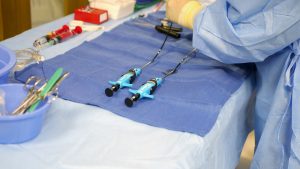Cardiac Catheter Ablation
The concept of cardiac catheter ablation directly resulted from the need for a minimally invasive treatment for cardiac arrhythmias, especially atrial fibrillation or Afib. Before the invention of cardiac catheter ablation, patients often only had a few choices in their treatment. Either hope that a lifestyle change would improve their arrhythmia hope that they were one of the 50% of patients for whom medication was effective, or ultimately have open-heart surgery. However, with the advent of cardiac catheter ablation, most patients can experience significant improvement or complete elimination of their arrhythmia with relatively low risk and minimal downtime.
The Types of Cardiac Catheter Ablation
Cardiac catheter ablation generally falls into two categories – those that use heat and alternately those that use cold to destroy the heart tissue causing errant electrical signals.
Radiofrequency or RF ablation uses radiofrequency (RF) waves to deliver targeted heat to the area of the heart, causing electrical malfunction. This heat is targeted to destroy the problematic heart tissue, but the surrounding healthy heart tissue is left intact and functioning normally.
RF is very safe and effective in the hands of an experienced electrophysiologist. Further, it does not preclude any other treatment or subsequent ablation. It has been used for decades in different specialties, and the proven technology has made its way to electrophysiology, which has changed the paradigm.
Cryoablation is very similar to radiofrequency ablation mentioned above; however, we use cold therapy to ablate or destroy problematic heart tissue. Cryoablation typically has very similar results as well. One distinguishing feature and potential advantage is regulating the degree of cold therapy applied to the heart tissue. As the heart tissue cools, it starts to lose function allowing us to “preview” whether the therapy will be successful.
If applying some cold therapy reduces the electrical signals from that area of the heart, we can apply full cryotherapy to destroy the tissue and make the improvement permanent. Much like radiofrequency ablation, choosing this strategy does not preclude us from further therapies should the ablation not be successful. Because it is also a catheter-based procedure, patients can rest assured that the risks and recovery times are minimized, especially in the hands of an experienced electrophysiologist like Dr. Moretta.
Please schedule a consultation with Dr. Moretta as the next step in understanding whether cardiac catheter ablation suits your particular arrhythmia.

